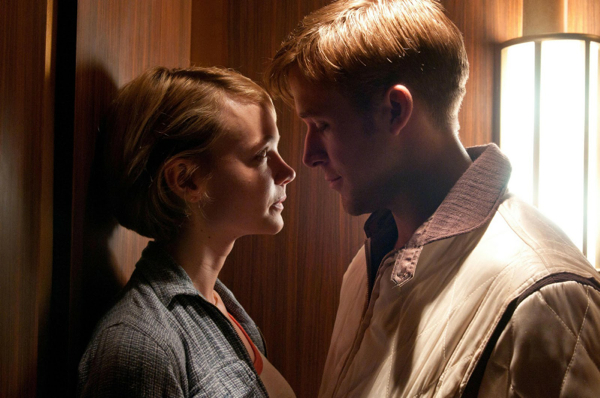Movie review by Greg Carlson
A stylish noir based on the novel by James Sallis, “Drive” instantly commands the attention of the design-conscious, thrill-seeking moviegoer. Despite its explosive violence and the sweaty embrace of young male fans ready to anoint Danish filmmaker Nicolas Winding Refn the next “auteur du jour,” “Drive” takes turns summoning our excitement and repelling it, asking us to believe that a man who wears a satiny, quilted silver racing jacket emblazoned with a large and ominous scorpion on the back doesn’t want to draw attention to himself.
Carried over from the book, that man is identified only as Driver, and Ryan Gosling plays him with an inscrutable smirk interrupted often by a protruding toothpick and rarely with conversation. As we draw closer to the taciturn wheelman, his day job performing automotive stunts in the make-believe world of the movies announces a confusion of fantasy and reality that facilitates the astonishingly immediate outbursts of violence that float in the liminal space carved out by only a certain kind of crime movie. Refn never identifies any of the film industry projects involving Driver, but the novel’s remake of “Thunder Road” might have been nice to keep.
In-demand talents like Gosling and Carey Mulligan might attract more attention, but “Drive” belongs to its most seasoned veterans. Albert Brooks plays a pragmatic but deadly mobster whose lacerating straight razor is given a run for its money by the old criminal’s equally sharp mouth. Every time he turns up, Brooks runs away with the film. Mulligan is given too little to do, but the doomed, forbidden romance – which culminates in a surreal, tour de force elevator car liebestod – cements Driver’s fate in the fraternity of God’s Lonely Men.
There is some question regarding Refn’s ability or interest in navigating away from ridiculousness and parody when it threatens to get too close. Certainly, Driver’s debt to the Man with No Name extends to the mayhem he doles out to the scumbags who are presented to us as if they deserve hammered knuckles and steel-toed stomps to the crania. Refn uses Driver’s twisted chivalry as one of several barriers to the peace and happiness he might otherwise find with Mulligan’s Irene (whose parallel Irina barely registers in the book), but the movie seems to tacitly endorse Driver’s bestial and barbaric modus operandi simply because he has been crossed by more gruesome monsters.
Even so, screenwriter Hossein Amini completely overhauls the terse, poetic voice of the novel, and the changes utterly transform Sallis’ cryptic prose and add flesh to the skeletal characters. On the big screen, “Drive” moves like a shark, gliding forward with singular purpose toward what might be the fundamental impulse to survive in the face of encroaching death. Sallis fractured the chronology, jumping forward and backward, but the movie smartly lights a slow-burning linear fuse that mimics the loud-quiet-loud Pixies dynamic so valued by Nirvana. Refn’s affinity for the head and the heady, a motif ideally expressed by the emotionless latex mask Driver occasionally dons, honors inspirations from David Lynch to Jean-Pierre Melville (although Refn singles out Alejandro Jodorowksy in the end credits). “Drive” is far from perfect, but its existential curiosity gives it a sizable lead over its competition.
